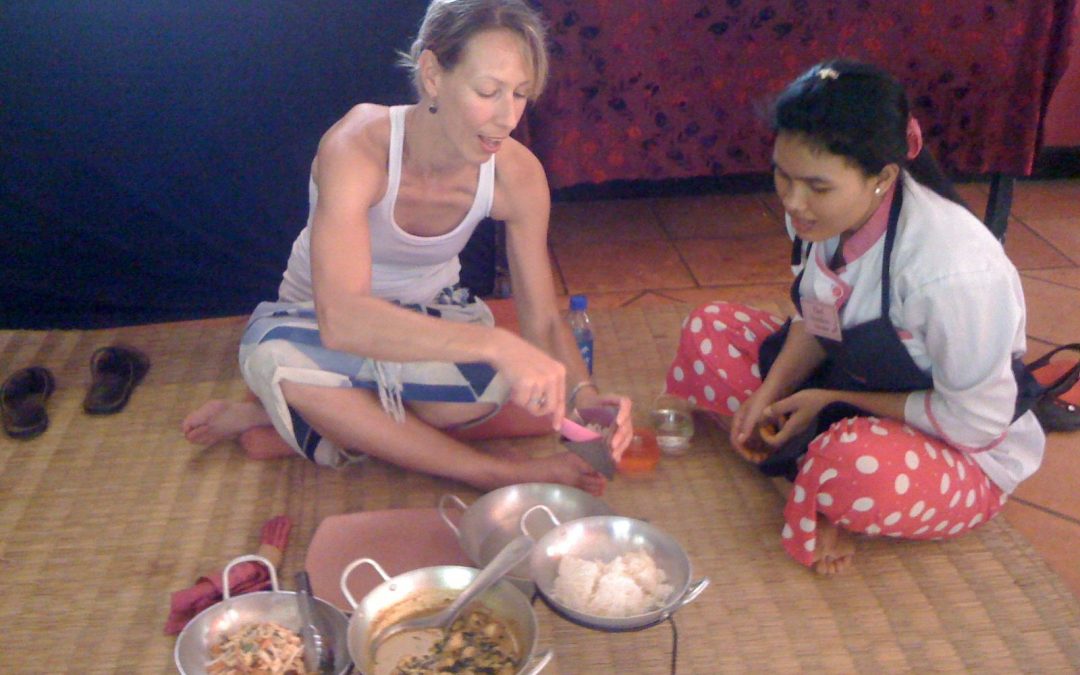On my last day in Siem Reap, Cambodia, Cooks in Tuk Tuks – a classic Khmer cooking class hosted by the talented chef at The RiverGarden Hotel – overshadowed even the spectacular Temples of Angkor.
I’ve taken cooking classes before; this one, however, was a true culinary adventure through the streets and markets of Siem Reap. (Warning to the squeamish: There may be some insects and snakes.)
I met Head Chef Sarouna at The RiverGarden around 10a and climbed into a “moto-tuk tuk,” necessary this week due to the extensive flooding in Siem Reap. (It’s the rainy season in Southeast Asia. I spent my fair share of time that afternoon traipsing through shin-deep muddy water in flip-flops.)
We visited a cluster of food carts in the center of town, where Sarouna pointed out a few Cambodian snacks – fried crickets and snakes. My guide at the Temples of Angkor earlier in the week swore that snake meat was the tastiest thing ever, but I opted for a cricket instead. Not half bad…basically just a salty crunch.
Down the street in the center of town, residents offered prepared food to locals and visitors alike. Because refrigeration is rare in Cambodia, most people buy, cook, and eat fresh food daily, boiling it over a clay and coal burner or in a saucepan on a single burner gas cooktop. Sounds great, right? Well, yes, from a health perspective it probably is; but Sarouna explained that, without the ability to store leftovers, preparing meals every day is a must and can be very time consuming. My mantra of “cook once, eat three times” clearly doesn’t work everywhere. (Another interesting tidbit about Cambodian eating habits: Cambodians will only eat white rice. Nutritionally superior brown rice is fed to Cambodian prisoners and is considered lower quality.)
Off we went to the produce market. Treasures I discovered there include:
Sao mao (rambutan) – Oh my god, WHY do we not grow this anywhere even remotely close to the U.S.?! It’s the most heavenly fruit ever created. A soft, white, fleshy ball housed in a gorgeous spiky red jewel case. Some are sweet; some are sour. It’s like Bertie Bott’s Every Flavor Beans with every bite.
Salty eggs – I didn’t buy one of these, but they looked cool.
Morning glory – Sort of like bok choy and used in many Khmer dishes.
Lemongrass – One of my absolute favorite flavors (and smells) is featured in many Khmer specialties, including amok. I don’t think I’d ever actually seen the plant though.
Galangal – Another favorite Khmer spice, galangal is one of the rhizome family and has a subtle ginger flavor. It’s used in curry pastes and soups.
Banana flower – Coolest thing ever. See the little baby bananas growing inside (pic below)? Turns out, that’s not the part you eat! It’s the flower petals that are used for cooking.
Turmeric – Another favorite spice of mine, but I’d never seen the finger-staining root from which it comes.
Cane juice – Made by pulping the sugar cane stalks right there on the street, this stuff isn’t as sweet as you’d think. A really refreshing drink when mixed with a little orange zest and served over ice.
Finally, the cooking began! Sarouna’s infinitely more capable cooking hands led me through the process of making three traditional Khmer dishes: Banana Flower Salad; Amok; and, for dessert, Sweet Potato, Sago, & Coconut Milk. The recipe for amok is below (some quantities are in metrics…those of you in the U.S. will have to do a little math).
Exploring a culture through its food is the only way to go for me. I literally ate my way through Siem Reap. If you visit, reserve your spot with Cooks in Tuk Tuks! Highly recommended.
What’s your favorite food or dish discovered in your travels? Tell me in the comments!
A note about Cambodia: While my cooking adventure – and tours of the spectacular Temples of Angkor – revealed some of the many treasures in this tiny country, it’s impossible to ignore the conditions in which most of the people live. Sally Struthers infomercials have made it something of a cliché and easy to ignore; but seeing it first hand made it very real for me. The Cambodian people have been through hell and back in the past few decades and yet their spirit and hospitality remain undimmed. The country is still struggling to get back on its feet.
As luck would have it, I stumbled across the headquarters of local non-profit ConCERT during my afternoon wanderings around the Old Market area of Siem Reap. Recognizing that the tourism boom offers great potential for solving some of the country’s poverty issues, ConCERT works with local NGO’s to channel the benefits of tourism back to the Cambodian people and offers tips to tourists on things to avoid (like supporting the ubiquitous begging around major tourist sites, which only makes things worse). If you’re interested in learning more about how you can help if you find yourself in Siem Reap (or even if you don’t), please check out ConCERT’s website at www.concertcambodia.org.
Amok Recipe
Serves 4 – 6.
Ingredients:
- 1 kg chicken or fish (use a firm, white fish – bas and lake fish are traditionally used, but I’m guessing that cod or tilapia would work)
For Kroeung (Khmer curry paste):
- 200g lemongrass stalks, trimmed, outer leaves removed, and chopped
- 100g galangal (or ginger)
- 2 teaspoons turmeric (fresh or powdered)
- 100g/4 cloves garlic
- 100g shallots
- 6 dried red chillies, soaked
- 4 Kaffir lime leaves, ribs removed
For Amok Mix:
- 3 tablespoons fish sauce
- 100g palm sugar
- 225 milliliters thick coconut milk
- 1 teaspoon salt
- 100 grams Nhor leaves, finely sliced, blanched, and strained (you can also use cabbage or spinach)
- 1 cup chicken stock
Directions:
- Clean fish or chicken. Slice and set aside.
- Process the Kroeung by roughly chopping ingredients and blending in a blender or pounding in a mortar and pestle with a little water until smooth. Set aside.
- Amok Mix – Combine all ingredients except for the Nhor leaves and chicken stock in a wok or sauce pan.
- Add the Kroeung and fish or chicken.
- Add chicken stock, simmer, and cook fish or chicken for 3 minutes.
- Add the Nhor leaves and cook for another 5 minutes.
- Serve with steamed rice.






